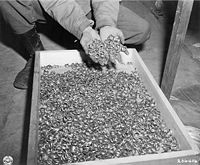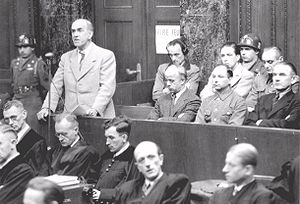
SS-Wirtschafts-Verwaltungshauptamt
Encyclopedia
The SS
-Wirtschafts-Verwaltungshauptamt (Main SS Economic and Administrative Department.) (WVHA) was responsible for managing the finances, supply systems and business projects for the Allgemeine-SS. It also ran the concentration camps
and was instrumental in overseeing the Holocaust
for the Third Reich through the Concentration Camps Inspectorate
and SS camp guards
.
worked with Walter Funk, Reichswirtschaftsminister, (Reich Minister of Economics), to oversee the financial aspects of The Holocaust
. Valuables such as gold watches, rings, even tooth fillings, glasses, and currency were taken from the inmates on arrival at the death camps
. These items were then sent back to Berlin
in WVHA-marked crates for processing at the Reichsbank
, under director, Emil Puhl
.
Between August 1942 and January 1945, a total of 76 WVHA transports arrived in Berlin.
In 1947, a detailed description showing the scale of the operation was given at the WVHA trials
at Nuremberg
. Evidence outlined how property and cash worth hundreds of millions of Reichsmarks was taken from the victims of Aktion Reinhard. It was collected from the details notes that had passed between SS and Police Leader
Odilo Globocnik
and Reichsführer
Heinrich Himmler
during the operation to kill most of the Jews in the General Government
.
Oswald Pohl
, had five main departments :
The WVHA was also put in charge of numerous commercial ventures that the SS has been increasingly engaged in since the mid-1930s.
 In 1942, the WVHA's main remit was to expand the SS's contribution to the war effort by using forced labor in armaments manufacture and construction projects. From these requirements grew the Amt W, the largest and most valuable division in WVHA. Using a limitless supply of slave labor provided by the concentration camp
In 1942, the WVHA's main remit was to expand the SS's contribution to the war effort by using forced labor in armaments manufacture and construction projects. From these requirements grew the Amt W, the largest and most valuable division in WVHA. Using a limitless supply of slave labor provided by the concentration camp
s, the Amt W was in a position to produce and deliver large quantities of products cheaply and quickly to the German market. Initially working prisoners in Arbeitslager
(Work Camp) were given better conditions than usual. But by late 1942, the Amt W demanded higher work rates without increasing food rations or providing better living conditions. As a result, SS guards
used murderous brutality to achieve higher quotas.
Amt W controlled the entire product cycle—from extraction of raw materials to manufacture and distribution—either directly or through a complex network of shell companies set up by Pohl
as privately owned businesses. After the invasion of the Soviet Union
, the SS also gained operational control of the majority of the Soviet manufacturing and mining assets on occupied territories.
The concentration camps gave the WVHA an unlimited labor resource. Amt W negotiated contracts with industrial firms regarding the use of slave labor in their factories. Arrangements covered the number of prisoners needed, the type of work they did, the number of SS guards to be assigned to the detail, food and lodging for the prisoners as well as the amount of money the firms would pay the SS for each prisoner per day.
Slave labor for private companies, included Heinkel
, IG Farben
, Junkers, Krupp
, Messerschmitt
, Salzgitter
, and Siemens-Schuckertwerke. At locations like Mauthausen
and Gusen at St. Georgen
, Pohl managed successfully to make leading armament producers like Messerschmitt GmbH
or Steyr-Daimler-Puch
fully dependable on deliveries by companies of Amtsgruppe W. Additionally, the SS was producing under contract military clothing and equipment for the Wehrmacht
.
By 1945, the SS-WVHA controlled over 500 businesses throughout Germany, with some products dominating entire markets such as Apollinaris mineral water
, Allach porcelain
or DEST (building material and armament)
.
 Some commercial ventures and assets owned or operated by the SS through its SS-WVHA units:
Some commercial ventures and assets owned or operated by the SS through its SS-WVHA units:
Schutzstaffel
The Schutzstaffel |Sig runes]]) was a major paramilitary organization under Adolf Hitler and the Nazi Party. Built upon the Nazi ideology, the SS under Heinrich Himmler's command was responsible for many of the crimes against humanity during World War II...
-Wirtschafts-Verwaltungshauptamt (Main SS Economic and Administrative Department.) (WVHA) was responsible for managing the finances, supply systems and business projects for the Allgemeine-SS. It also ran the concentration camps
Nazi concentration camps
Nazi Germany maintained concentration camps throughout the territories it controlled. The first Nazi concentration camps set up in Germany were greatly expanded after the Reichstag fire of 1933, and were intended to hold political prisoners and opponents of the regime...
and was instrumental in overseeing the Holocaust
The Holocaust
The Holocaust , also known as the Shoah , was the genocide of approximately six million European Jews and millions of others during World War II, a programme of systematic state-sponsored murder by Nazi...
for the Third Reich through the Concentration Camps Inspectorate
Concentration Camps Inspectorate
The Concentration Camps Inspectorate was the central SS administrative and managerial authority for the concentration camps of the Third Reich. Created by Theodor Eicke, it was originally known as the "General Inspection of the Enhanced SS-Totenkopfstandarten, after Eicke's position in the SS...
and SS camp guards
SS-Totenkopfverbände
SS-Totenkopfverbände , meaning "Death's-Head Units", was the SS organization responsible for administering the Nazi concentration camps for the Third Reich....
.
Economics of The Holocaust
SS-Obergruppenführer Oswald PohlOswald Pohl
Oswald Pohl was a Nazi official and member of the SS , involved in the mass murders of Jews in concentration camps, the so-called Final Solution.-Early years:...
worked with Walter Funk, Reichswirtschaftsminister, (Reich Minister of Economics), to oversee the financial aspects of The Holocaust
The Holocaust
The Holocaust , also known as the Shoah , was the genocide of approximately six million European Jews and millions of others during World War II, a programme of systematic state-sponsored murder by Nazi...
. Valuables such as gold watches, rings, even tooth fillings, glasses, and currency were taken from the inmates on arrival at the death camps
Nazi concentration camps
Nazi Germany maintained concentration camps throughout the territories it controlled. The first Nazi concentration camps set up in Germany were greatly expanded after the Reichstag fire of 1933, and were intended to hold political prisoners and opponents of the regime...
. These items were then sent back to Berlin
Berlin
Berlin is the capital city of Germany and is one of the 16 states of Germany. With a population of 3.45 million people, Berlin is Germany's largest city. It is the second most populous city proper and the seventh most populous urban area in the European Union...
in WVHA-marked crates for processing at the Reichsbank
Reichsbank
The Reichsbank was the central bank of Germany from 1876 until 1945. It was founded on 1 January 1876 . The Reichsbank was a privately owned central bank of Prussia, under close control by the Reich government. Its first president was Hermann von Dechend...
, under director, Emil Puhl
Emil Puhl
Dr. Emil Puhl was a Nazi economist and banking official during World War II. He was director and vice-president of Germany's Reichsbank during World War II and also served as a director for the Bank for International Settlements at Basel . He was instrumental in moving Nazi gold during the war...
.
Between August 1942 and January 1945, a total of 76 WVHA transports arrived in Berlin.
In 1947, a detailed description showing the scale of the operation was given at the WVHA trials
Nuremberg Trials
The Nuremberg Trials were a series of military tribunals, held by the victorious Allied forces of World War II, most notable for the prosecution of prominent members of the political, military, and economic leadership of the defeated Nazi Germany....
at Nuremberg
Nuremberg
Nuremberg[p] is a city in the German state of Bavaria, in the administrative region of Middle Franconia. Situated on the Pegnitz river and the Rhine–Main–Danube Canal, it is located about north of Munich and is Franconia's largest city. The population is 505,664...
. Evidence outlined how property and cash worth hundreds of millions of Reichsmarks was taken from the victims of Aktion Reinhard. It was collected from the details notes that had passed between SS and Police Leader
SS and Police Leader
SS and Police Leader was a title for senior Nazi officials that commanded large units of the SS, of Gestapo and of the regular German police during and prior to World War II.Three levels of subordination were established for bearers of this title:...
Odilo Globocnik
Odilo Globocnik
Odilo Lotario Globocnik was a prominent Austrian Nazi and later an SS leader. He was an acquaintance of Adolf Eichmann, who played a major role in the extermination of Jews and others during the Holocaust...
and Reichsführer
Reichsführer-SS
was a special SS rank that existed between the years of 1925 and 1945. Reichsführer-SS was a title from 1925 to 1933 and, after 1934, the highest rank of the German Schutzstaffel .-Definition:...
Heinrich Himmler
Heinrich Himmler
Heinrich Luitpold Himmler was Reichsführer of the SS, a military commander, and a leading member of the Nazi Party. As Chief of the German Police and the Minister of the Interior from 1943, Himmler oversaw all internal and external police and security forces, including the Gestapo...
during the operation to kill most of the Jews in the General Government
General Government
The General Government was an area of Second Republic of Poland under Nazi German rule during World War II; designated as a separate region of the Third Reich between 1939–1945...
.
Organization
The WVHA, which was expanded in February 1942 under the command of SS-ObergruppenführerObergruppenführer
Obergruppenführer was a Nazi Party paramilitary rank that was first created in 1932 as a rank of the SA and until 1942 it was the highest SS rank inferior only to Reichsführer-SS...
Oswald Pohl
Oswald Pohl
Oswald Pohl was a Nazi official and member of the SS , involved in the mass murders of Jews in concentration camps, the so-called Final Solution.-Early years:...
, had five main departments :
- Amt A, Finance, Law and Administration
- Amt B, Supply, Administration and Equipment
- Amt C, Buildings and Works
- Amt D, Concentration CampsConcentration Camps InspectorateThe Concentration Camps Inspectorate was the central SS administrative and managerial authority for the concentration camps of the Third Reich. Created by Theodor Eicke, it was originally known as the "General Inspection of the Enhanced SS-Totenkopfstandarten, after Eicke's position in the SS...
(SS-TVSS-TotenkopfverbändeSS-Totenkopfverbände , meaning "Death's-Head Units", was the SS organization responsible for administering the Nazi concentration camps for the Third Reich....
under SS GruppenfuhrerGruppenführerGruppenführer was an early paramilitary rank of the Nazi Party, first created in 1925 as a senior rank of the SA.-SS rank:...
Richard GlücksRichard GlücksRichard Glücks was a high-ranking Nazi official. He attained the rank of a SS-Gruppenführer and a Generalleutnant of the Waffen-SS and from 1939 until the end of World War II was the head of Amt D: Konzentrationslagerwesen of the WVHA; the highest-ranking Concentration Camps Inspector in Nazi...
) - Amt W, Economics
The WVHA was also put in charge of numerous commercial ventures that the SS has been increasingly engaged in since the mid-1930s.
Amtsgruppe W

Nazi concentration camps
Nazi Germany maintained concentration camps throughout the territories it controlled. The first Nazi concentration camps set up in Germany were greatly expanded after the Reichstag fire of 1933, and were intended to hold political prisoners and opponents of the regime...
s, the Amt W was in a position to produce and deliver large quantities of products cheaply and quickly to the German market. Initially working prisoners in Arbeitslager
Arbeitslager
Arbeitslager is a German language word which means labor camp.The German government under Nazism used forced labor extensively, starting in the 1930s but most especially during World War II....
(Work Camp) were given better conditions than usual. But by late 1942, the Amt W demanded higher work rates without increasing food rations or providing better living conditions. As a result, SS guards
SS-Totenkopfverbände
SS-Totenkopfverbände , meaning "Death's-Head Units", was the SS organization responsible for administering the Nazi concentration camps for the Third Reich....
used murderous brutality to achieve higher quotas.
Amt W controlled the entire product cycle—from extraction of raw materials to manufacture and distribution—either directly or through a complex network of shell companies set up by Pohl
Oswald Pohl
Oswald Pohl was a Nazi official and member of the SS , involved in the mass murders of Jews in concentration camps, the so-called Final Solution.-Early years:...
as privately owned businesses. After the invasion of the Soviet Union
Soviet Union
The Soviet Union , officially the Union of Soviet Socialist Republics , was a constitutionally socialist state that existed in Eurasia between 1922 and 1991....
, the SS also gained operational control of the majority of the Soviet manufacturing and mining assets on occupied territories.
The concentration camps gave the WVHA an unlimited labor resource. Amt W negotiated contracts with industrial firms regarding the use of slave labor in their factories. Arrangements covered the number of prisoners needed, the type of work they did, the number of SS guards to be assigned to the detail, food and lodging for the prisoners as well as the amount of money the firms would pay the SS for each prisoner per day.
Slave labor for private companies, included Heinkel
Heinkel
Heinkel Flugzeugwerke was a German aircraft manufacturing company founded by and named after Ernst Heinkel. It is noted for producing bomber aircraft for the Luftwaffe in World War II and for important contributions to high-speed flight.-History:...
, IG Farben
IG Farben
I.G. Farbenindustrie AG was a German chemical industry conglomerate. Its name is taken from Interessen-Gemeinschaft Farbenindustrie AG . The company was formed in 1925 from a number of major companies that had been working together closely since World War I...
, Junkers, Krupp
Krupp
The Krupp family , a prominent 400-year-old German dynasty from Essen, have become famous for their steel production and for their manufacture of ammunition and armaments. The family business, known as Friedrich Krupp AG Hoesch-Krupp, was the largest company in Europe at the beginning of the 20th...
, Messerschmitt
Messerschmitt
Messerschmitt AG was a famous German aircraft manufacturing corporation named for its chief designer, Willy Messerschmitt, and known primarily for its World War II fighter aircraft, notably the Bf 109 and Me 262...
, Salzgitter
Salzgitter
Salzgitter is an independent city in southeast Lower Saxony, Germany, located between Hildesheim and Braunschweig. Together with Wolfsburg and Braunschweig, Salzgitter is one of the seven Oberzentren of Lower Saxony...
, and Siemens-Schuckertwerke. At locations like Mauthausen
Mauthausen-Gusen concentration camp
Mauthausen Concentration Camp grew to become a large group of Nazi concentration camps that was built around the villages of Mauthausen and Gusen in Upper Austria, roughly east of the city of Linz.Initially a single camp at Mauthausen, it expanded over time and by the summer of 1940, the...
and Gusen at St. Georgen
Sankt Georgen an der Gusen
Sankt Georgen an der Gusen is a small market town in Upper Austria, Austria, between the municipalities of Luftenberg and Langenstein...
, Pohl managed successfully to make leading armament producers like Messerschmitt GmbH
Messerschmitt
Messerschmitt AG was a famous German aircraft manufacturing corporation named for its chief designer, Willy Messerschmitt, and known primarily for its World War II fighter aircraft, notably the Bf 109 and Me 262...
or Steyr-Daimler-Puch
Steyr-Daimler-Puch
Steyr-Daimler-Puch was a large manufacturing conglomerate based in Steyr, Austria, which was broken up in stages between 1987 and 2001. The component parts and operations continued to exist under separate ownership and new names.-History:...
fully dependable on deliveries by companies of Amtsgruppe W. Additionally, the SS was producing under contract military clothing and equipment for the Wehrmacht
Wehrmacht
The Wehrmacht – from , to defend and , the might/power) were the unified armed forces of Nazi Germany from 1935 to 1945. It consisted of the Heer , the Kriegsmarine and the Luftwaffe .-Origin and use of the term:...
.
By 1945, the SS-WVHA controlled over 500 businesses throughout Germany, with some products dominating entire markets such as Apollinaris mineral water
Apollinaris (water)
Apollinaris is a German naturally sparkling mineral water, very well known in German-speaking countries as "The Queen of Table Waters".The spring was discovered by chance in 1852 in Georg Kreuzberg’s vineyard, in Bad Neuenahr, Germany...
, Allach porcelain
Allach (porcelain)
Allach porcelain was produced in Germany between 1935 and 1945.-History:Master of ceramics Franz Nagy had owned the land since 1925 that the Munich-Allach facility was built on. With his business partner, the porcelain artist Prof. Karl Diebitsch, he began the production of porcelain art...
or DEST (building material and armament)
DEST
The D. E. S. T. , was an SS owned company originally created to procure and manufacture building materials for state construction projects in Nazi Germany DEST was a subsidiary company of Amtsgruppe W of SS-Wirtschafts- und Verwaltungshauptamt...
.
SS commercial operations

- Land and forests
- Brick factories
- Stone quarries
- Fine porcelain and pottery factories
- Building materials factories
- Cement factory
- Mineral water extraction and bottling
- Meat processing
- Bakeries
- Small arms manufacturing and repair
- Wooden furniture design and production
- Military clothing and accessories
- Herbal medicine
- Fish processing
- Publishing of books and magazines on Germanic culture and history
- Art acquisition and restoration
- Production of Damascus bladesDamascus steelDamascus steel was a term used by several Western cultures from the Medieval period onward to describe a type of steel used in swordmaking from about 300 BCE to 1700 CE. These swords are characterized by distinctive patterns of banding and mottling reminiscent of flowing water...
External links
- The Building today (former WVHA) at Berlin Lichterfelde) and Informationsdesks (1999; R. Golz)

